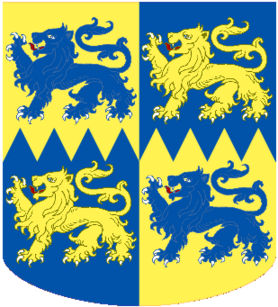Related Research Articles

Marquess of Aberdeen and Temair, in the County of Aberdeen, in the County of Meath and in the County of Argyll, is a title in the Peerage of the United Kingdom. It was created on 4 January 1916 for John Hamilton-Gordon, 7th Earl of Aberdeen.

Earl of Albemarle is a title created several times from Norman times onwards. The word Albemarle is derived from the Latinised form of the French county of Aumale in Normandy, other forms being Aubemarle and Aumerle. It is described in the patent of nobility granted in 1697 by William III to Arnold Joost van Keppel as "a town and territory in the Dukedom of Normandy."

Earl of Lindsey is a title in the Peerage of England. It was created in 1626 for the 14th Baron Willoughby de Eresby. He was First Lord of the Admiralty from 1635 to 1636 and also established his claim in right of his mother to the hereditary office of Lord Great Chamberlain of England. Lord Lindsey fought on the Royalist side in the Civil War and was killed at the Battle of Edgehill on 23 October 1642. He was succeeded by his son, the second Earl. He also fought at Edgehill and surrendered to the Parliamentarians in order to attend his mortally wounded father. Lord Lindsey later fought at the First Battle of Newbury, Second Battle of Newbury, and at Naseby. His son from his second marriage, James, was created Earl of Abingdon in 1682. He was succeeded by his son from his first marriage to Martha Cockayne, the third Earl. He represented Boston in the House of Commons and served as Lord Lieutenant of Lincolnshire.

Earl of Abingdon is a title in the Peerage of England. It was created on 30 November 1682 for James Bertie, 5th Baron Norreys of Rycote. He was the eldest son of Montagu Bertie, 2nd Earl of Lindsey by his second marriage to Bridget, 4th Baroness Norreys de Rycote, and the younger half-brother of Robert Bertie, 3rd Earl of Lindsey. His mother's family descended from Sir Henry Norris, who represented Berkshire and Oxfordshire in the House of Commons and served as Ambassador to France. In 1572 he was summoned by writ to Parliament as Lord Norreys de Rycote. He was succeeded by his grandson, the second Baron. In 1621 he was created Viscount Thame and Earl of Berkshire in the Peerage of England. He had no sons and on his death in 1624 the viscountcy and earldom became extinct. He was succeeded in the barony by his daughter Elizabeth, the third holder of the title. On her death the title passed to her daughter, the aforementioned Bridget, the fourth Baroness, second wife of the second Earl of Lindsey.

Baron Willoughby de Eresby is a title in the Peerage of England. It was created in 1313 for Robert de Willoughby. Since 1983, the title has been held by Jane Heathcote-Drummond-Willoughby, 28th Baroness Willoughby de Eresby.

Baron Cullen of Ashbourne, of Roehampton in the County of Surrey, is a title in the Peerage of the United Kingdom. It was created on 21 April 1920 for Sir Brien Cokayne, Governor of the Bank of England from 1918 to 1920. As of 2017 the title is held by his grandson, the fourth Baron, who succeeded his uncle in 2016.

Robert Bertie, 1st Duke of Ancaster and Kesteven PC, styled17th Baron Willoughby de Eresby between 1666 and 1701, and known as 4th Earl of Lindsey between 1701 and 1706, and as 1st Marquess of Lindsey between 1706 and 1715, was a British statesman and nobleman.

George Edward Cokayne,, was an English genealogist and long-serving herald at the College of Arms in London, who eventually rose to the rank of Clarenceux King of Arms. He wrote the authoritative and standard reference works The Complete Peerage and The Complete Baronetage.

Lieutenant-General Albemarle Bertie, 9th Earl of Lindsey was a British nobleman and general.
Earl of Thomond was an hereditary title in the Peerage of Ireland. It was created twice for the O'Brien dynasty which is an ancient Irish sept native to north Munster.
Robert Bertie, 3rd Earl of Lindsey PC FRS, styled Lord Willoughby de Eresby from 1642 to 1666, was an English nobleman.
Sir William Cockayne (Cokayne) was a seventeenth-century merchant, alderman, and Lord Mayor of the City of London.

Brien Ibrican Cokayne, 1st Baron Cullen of Ashbourne was a British businessman and banker.
There have been four baronetcies created for people with the surname Lee, all extinct.
Gentleman of the Bedchamber was a title in the royal household of the Kingdom of England from the 11th century, later used also in the Kingdom of Great Britain.

Sir George Villiers was an English knight and country gentleman. He was a High Sheriff of Leicestershire for the year 1591, and later was briefly a Knight of the Shire, a Member of Parliament representing the county of Leicestershire.
Montague Peregrine Albemarle Bertie, 12th Earl of Lindsey, DL, styled Lord Bertie from 1877 until 1899, was an English nobleman, the only son of Montague Bertie, 11th Earl of Lindsey.

The Baronetcy of Cockayne of Ashbourne was created in the Baronetage of England on 10 January 1642 for Aston Cockayne, Lord of Ashbourne Hall, Derbyshire and Pooley Hall, Polesworth, Warwickshire.

Wingfield Cromwell, 2nd Earl of Ardglass, DCL, was an English nobleman, son of Thomas Cromwell, 1st Earl of Ardglass and Elizabeth Meverell. He held the subsidiary titles of 2nd Viscount Lecale and 5th Baron Cromwell of Oakham.
References
- ↑ Gentleman's Magazine : 489. November 1855.Missing or empty
|title=(help)